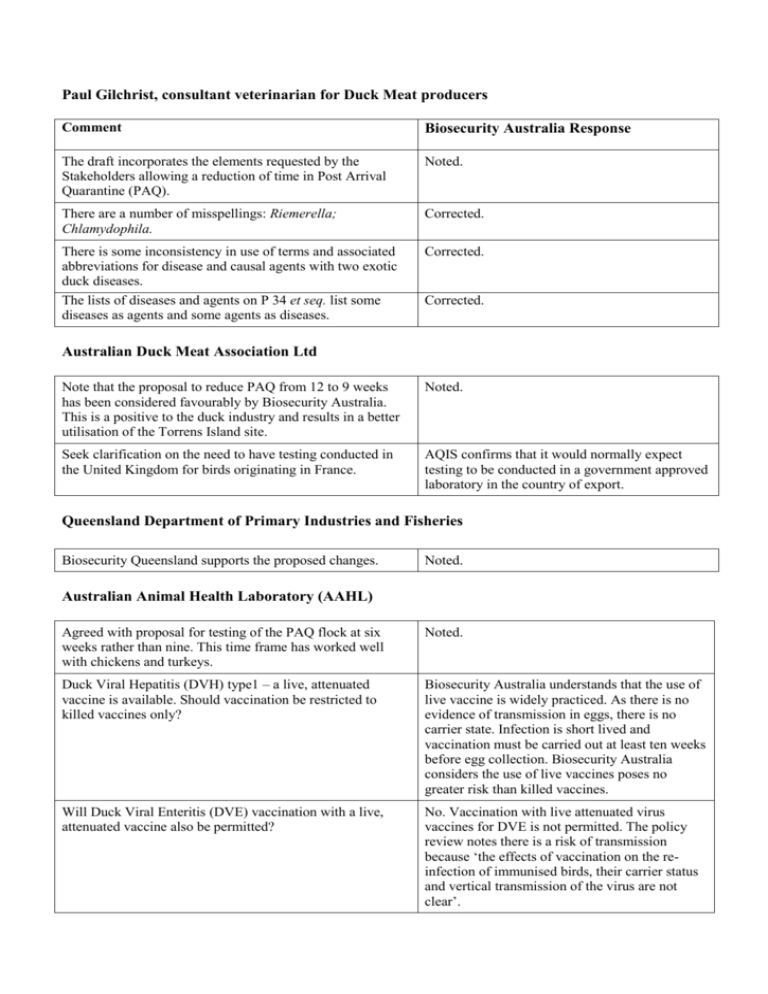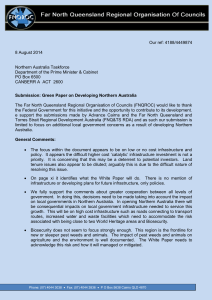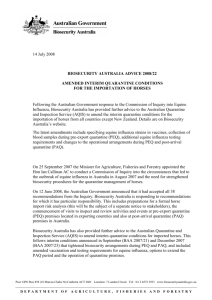Paul Gilchrist, consultant veterinarian for Duck Meat producers
advertisement

Paul Gilchrist, consultant veterinarian for Duck Meat producers Comment Biosecurity Australia Response The draft incorporates the elements requested by the Stakeholders allowing a reduction of time in Post Arrival Quarantine (PAQ). Noted. There are a number of misspellings: Riemerella; Chlamydophila. Corrected. There is some inconsistency in use of terms and associated abbreviations for disease and causal agents with two exotic duck diseases. The lists of diseases and agents on P 34 et seq. list some diseases as agents and some agents as diseases. Corrected. Corrected. Australian Duck Meat Association Ltd Note that the proposal to reduce PAQ from 12 to 9 weeks has been considered favourably by Biosecurity Australia. This is a positive to the duck industry and results in a better utilisation of the Torrens Island site. Noted. Seek clarification on the need to have testing conducted in the United Kingdom for birds originating in France. AQIS confirms that it would normally expect testing to be conducted in a government approved laboratory in the country of export. Queensland Department of Primary Industries and Fisheries Biosecurity Queensland supports the proposed changes. Noted. Australian Animal Health Laboratory (AAHL) Agreed with proposal for testing of the PAQ flock at six weeks rather than nine. This time frame has worked well with chickens and turkeys. Noted. Duck Viral Hepatitis (DVH) type1 – a live, attenuated vaccine is available. Should vaccination be restricted to killed vaccines only? Biosecurity Australia understands that the use of live vaccine is widely practiced. As there is no evidence of transmission in eggs, there is no carrier state. Infection is short lived and vaccination must be carried out at least ten weeks before egg collection. Biosecurity Australia considers the use of live vaccines poses no greater risk than killed vaccines. Will Duck Viral Enteritis (DVE) vaccination with a live, attenuated vaccine also be permitted? No. Vaccination with live attenuated virus vaccines for DVE is not permitted. The policy review notes there is a risk of transmission because ‘the effects of vaccination on the reinfection of immunised birds, their carrier status and vertical transmission of the virus are not clear’. DVH type1 – How will we differentiate between vaccinated and previously infected ducks? There is no requirement to test vaccinated breeder flocks so Biosecurity Australia assumes this comment refers to the PAQ duckling flock. In the case of progeny of vaccinated (and previously infected) breeders, the policy review notes there is evidence that maternally derived antibody will have disappeared by the time of testing at six weeks post-hatch. All evidence also indicates that an infection will cause significant clinical disease which will be investigated. DVH and DVE are highly lethal to young ducks therefore any infection will become obvious very quickly. Agreed, this is acknowledged in the policy review. Neither virus (DVH, DVE) is reported to be transmitted vertically. There is no evidence that DVH is transmitted vertically. Trans-ovarian transmission of DVE has been demonstrated in infected carrier ducks. Do we need to test for DVH 2 and DVH 3 if the eggs are imported from countries in which these viruses are present? Yes, the donor flock is to be tested if necessary. However, these diseases appear to be confined to the United Kingdom and United States, and have not been reported since the 1980s. It is expected that most, if not all, consignments will be able to be certified free of the disease and thus testing will not be required. Newcastle disease – how will we differentiate between vaccinated and previously infected birds? Noting that vaccination with live virus vaccines is not permitted any virus isolated from either the donor flock or the PAQ duckling flock would be considered a wild virus and signal that the import requirement have not been met. Infection in the PAQ flock arising through vertical transmission (from infected vaccinated or unvaccinated breeders) would be detected by virus isolation of the PAQ flock and/or seroconversion in the chicken sentinel flock. Is vaccination against Salmonella to be allowed? There is no specific prescription against Salmonella vaccination. There is a requirement that the source flock be serologically negative to S. Enteritidis. Are Salmonella arizona strains seen overseas more virulent than Australian strains? If so the proposal to change this condition should be reviewed. Biosecurity Australia could find no evidence that overseas strains are more virulent than those in Australia. Biosecurity Australia considers that S. arizona remains a potential hazard for turkey and chicken egg imports. In contrast, there is minimal evidence of infection in ducks (a single 1953 reference) – on this basis it was removed from the hazard list. There are at least 21 different serotypes of Reimerella anatipestifer that do not cross protect. Which serotypes are present in Australia and are there differences in virulence between the serotypes? This disease will probably kill young ducks if present. Biosecurity Australia could find no evidence that overseas strains are more virulent than those in Australia. There are industry reports that highly virulent strains are already present in this country. Salmonella Typhimurium DT104 – is AAHL able to do such test or would we (AAHL) have to send isolates to another The final policy has been amended to delete a footnote advice to send Salmonella isolates for lab? sero-typing specifically to Institute of Medical and Veterinary Science in Adelaide. Biosecurity Australia considered that it was not necessary to specify a particular laboratory. Salmonella Typhimurium DT104 – sending out isolates creates another set of problems as does establishing the antibiotic sensitivity test at AAHL. Can these be done by molecular characterisation of isolates rather than traditional culture methods? Biosecurity Australia considers that the new policy allows scope for alternative validated methods such as the molecular characterisation of isolates. AAHL also made the following comments that Biosecurity Australia will consider in future reviews of the policy. General comments on the avian importation program (chickens, turkeys, ducks and other species; eggs for hatching and live birds):1. The current avian importation protocols are biased against isolation of viruses. The pre-arrival quarantine and certified absence of disease, combined with the six week time between arrival or hatching and swabbing almost certainly guarantees that, if the birds are infected, any shedding of low path viruses would have ceased by the time of sampling. Influenza, avian paramyxo- and IBD viruses are excreted for periods between 10 days (chickens) and a maximum of 28 days (ducks) but generally much shorter times, so the window in which these viruses can be isolated from infected birds is small. Any high path viruses would have prevented the eggs hatching or have killed the chicks and the mortality event investigated. 2. We suggest that the requirement for virus isolation on swabs collected at 6 weeks post hatching or arrival be removed. Any mortality event in the imported birds should still be investigated and samples processed for virus isolation and bacterial culture. Note that all the hatching egg quarantine requirements specify that where any evidence of disease is observed, a full investigation is to be carried out and the resulting reports submitted to AQIS. 3. We suggest that virus isolation on swabs collected at 6 weeks post hatching be replaced with serology for the agents of concern. If the birds are infected in-ovo they will either die or developed antibodies by 6 weeks of age. Infection in post-arrival quarantine this suggests a breakdown of the quarantine procedures. 4. To validate this approach we suggest running testing on several shipments in parallel, i.e. doing the testing as required under the existing protocol but also running serological tests for agents of concern on the same shipments of birds. This will allow us to compare these two approaches to testing birds in quarantine and determine if serological testing alone will provide equivalent sensitivity and specificity to virus isolation and bacterial culture. 5. Removing the requirement for virus isolation and substituting serology will reduce the overall cost of testing to the importer and reduce the time for AAHL to provide a final report. Virus isolations may take two weeks and virus neutralisation tests for serology may take up to 5 days but most serological tests can be done in one day. 6. The isolation of any agent from imported poultry should be considered extremely seriously, irrespective of whether that agent is already present in Australia. Variations in virulence between different isolates of the same agent are common and the risk to the Australian poultry industry of the introduction of a new agent or biotype is too great to allow infected poultry into Australia. If an agent is isolated or antibodies detected AQIS should cull the infected birds or extend the quarantine period until any risk of transmission has gone before allowing the birds into Australia. Consideration should be given to the implications to our disease-free status if antibody-positive birds are imported into Australia. There is an agreed process that is to be followed should an investigation or specified test indicate the presence of a pathogen. This is detailed in Appendix 5.1 (7) ––‘Recommended quarantine requirement for the importation of hatching duck eggs from approved countries’ ––of the policy review. The quarantine conditions for the hatching eggs of hens and of turkeys contain similar requirements.







